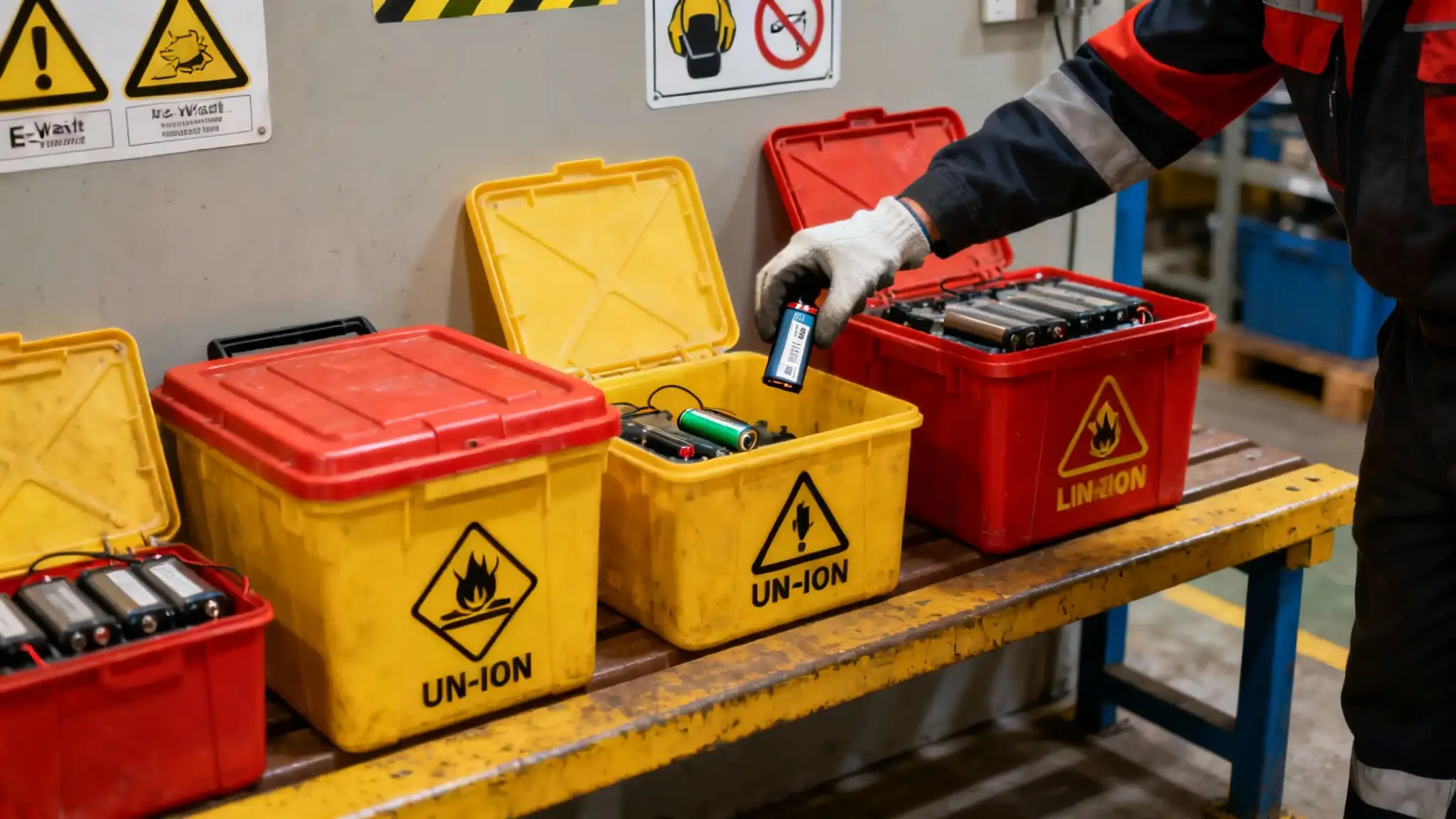Purpose: This Standard Operating Procedure (SOP) defines how an e-waste or ITAD facility safely receives, triages, stores, and ships hazardous fractions—especially lithium-ion batteries, CRT glass, and mercury-containing lamps—to minimize fire, exposure, and environmental risk while maintaining audit-ready records.
Scope: Applies to all staff handling inbound equipment and parts, including receiving, triage, refurbishment, demanufacturing, storage, and shipping. Covers small and large format batteries, lead-acid, NiCd/NiMH, CRT devices and cullet, fluorescent/CFL/UV lamps, and incidental spill/breakage response.
1) Roles, Training, and Competency
- EHS Lead: owns this SOP, conducts hazard assessments, approves PPE, and reviews incidents/CAPAs.
- Receiving/Triage Techs: identify hazardous fractions on arrival, apply segregation rules, complete logs.
- Demanufacturing Techs: remove batteries, lamps, and CRTs per procedure; bag/tag and stage for storage.
- Warehouse/Logistics: maintain storage limits, aisle spacing, labels, and compliant outbound packaging.
- All Staff: complete initial training and annual refreshers on battery risks, mercury response, and glass handling.
Training checklist (retain sign-in sheets):
- Hazard recognition: swollen/damaged batteries, broken lamps, CRT evacuation hazards.
- Fire safety and thermal runaway basics; extinguisher selection and locations.
- Spill/breakage response and notification tree.
- Proper use of PPE and inspection of gloves/respirators/eye protection.
- Recordkeeping: what to log, how, and where.
2) PPE & Work Area Controls (Quick Matrix)
- Li-ion battery handling: cut-resistant gloves, safety glasses/face shield for damaged units, antistatic sleeve/bag, non-conductive tools, fire-resistant container with inert fill for quarantine.
- Lead-acid/NiCd/NiMH: chemical-resistant gloves (nitrile), safety glasses, apron for wet batteries; neutralizer and absorbent within 10 m.
- CRT removal/cullet: cut-resistant gloves, long sleeves, safety glasses + face shield, HEPA vac available.
- Mercury lamps: cut-resistant gloves, safety glasses; if breakage cleanup, add disposable coveralls and P100 respirator per exposure assessment.
Area controls
- No smoking or open flames.
- Charging only at designated, supervised stations (never in storage areas).
- Keep Class ABC extinguishers readily available; keep water or water-mist for cooling Li-ion incidents; maintain sand/inert absorbent for containment.
- Post “No Pallet Jacks” signs where glass/lamps are stored if floor vibration risks tipping.
3) Receiving & Triage (All Streams)
- Visual screen at dock
- Look for swollen, hot, hissing, or leaking batteries; wet lead-acid; crushed CRTs; broken lamps.
- Use an IR thermometer for suspicious packs; if > 60°C (140°F), treat as thermal risk and move to outdoor or isolated quarantine immediately.
- Immediate isolation
- Damaged/defective/dangerous (DDD) batteries → Battery Quarantine Bin with inert material (vermiculite or sand), lid on, labeled “Damaged Li-ion—Do Not Charge.”
- Broken CRT or lamp → secure area, prevent tracking, begin breakage procedure.
- Identification & labeling
- Apply hazard label, date, stream (Li-ion, L/A, NiCd, CRT, Mercury), condition (Intact / Damaged), and weight or count.
- Record in Hazardous Fractions Intake Log before moving to storage.
- Segregation
- Separate by chemistry (Li-ion vs L/A vs NiCd/NiMH).
- Keep intact away from damaged.
- CRT devices separate from lamps and batteries.
- Maintain minimum 1 m clearance between battery stacks and any ignition sources.
4) Lithium-Ion Batteries (Primary Fire Risk)
Key risks: internal short leading to thermal runaway; re-triggering after initial cooling; electrical short from terminals contacting metal.
Do / Don’t basics
- Do tape or cap terminals; use non-conductive containers; keep SoC low; cool overheated packs.
- Don’t crush, puncture, or charge unknown packs; don’t mix damaged with intact; don’t use metal bins.
Removal & Preparation
- Depower devices; wait 5 minutes before removal.
- Use non-conductive tools; remove batteries gently.
- Tape all exposed terminals; for multi-cell packs, insulate harness connectors.
Storage
- Intact Li-ion: rigid, non-conductive containers with lids; layers separated by cardboard; terminal-taped.
- Damaged/Swollen: place individually in fire-resistant container with inert fill; lid closed.
- Limits: set conservative max per zone (e.g., ≤ 300 kg intact per bay; ≤ 30 kg damaged in quarantine). Document your facility’s limits and keep a tally.
Charging policy
- Charging is prohibited unless you run a controlled test area with fire detection, 24/7 monitoring, non-combustible surrounds, and immediate access to suppression and evacuation routes. Never charge suspect packs.
Thermal incident response (small device battery)
- Alert nearby staff; pull alarm if escalating.
- Do not smother with Class D agent for Li-ion; cool generously with water or water-mist to stop propagation and cool adjacent packs.
- Keep cooling until steam/smoke stops and temperature normalizes; monitor 60 minutes for re-ignition.
- Move debris to metal tray, soak-cool outside if possible, then bag as incident waste once cold.
Documentation
- Log incident time, location, product type, suspected cause (crush, puncture, charging, unknown), actions taken, cooling duration, and CAPA.
5) Lead-Acid, NiCd, and NiMH Batteries
Lead-acid (flooded/AGM/gel)
- Keep upright on acid-resistant trays; neutralizer and absorbent within reach.
- If leaking, neutralize and contain; move to leaker bin with absorbent; label “Hazard—Battery Acid.”
- No mixing with Li-ion; different pallets and zones.
NiCd/NiMH
- Tape terminals; store in closed, non-conductive tubs.
- Treat leaking cells as chemical exposure; bag and stage as hazardous waste.
Outbound prep (general)
- Use sturdy, tested packaging appropriate for battery type; cushion and segregate layers; verify labels and orientation markings; ensure counts/weights match shipment docs.
6) CRT Devices and CRT Glass
Risks: implosion hazards, leaded glass dust, cuts.
Removal
- De-energize and discharge per procedure before opening CRT devices.
- Use hand tools; avoid impact. Remove tube intact whenever feasible.
Handling
- Wear cut-resistant gloves, long sleeves, and full face protection.
- Keep tubes vertical when moving; do not stack more than one layer without custom racking.
- If the tube breaks, do not sweep: use HEPA vac and damp wipes; collect shards in rigid containers.
Cullet management
- Store CRT cullet in rigid, closable drums or lined gaylords; lids closed when not loading.
- Label with stream, date, and net weight; keep records of lot origin (device types, sources).
Housekeeping
- Daily floor inspection for glass; use HEPA vac only.
- Maintain walkways free of shards; change gloves when contaminated to avoid cross-tracking.
7) Mercury-Containing Lamps (Fluorescent, CFL, UV, HID)
Risks: airborne mercury vapor on breakage; cuts from glass.
Intact lamps
- Keep in original boxes or purpose-built lamp containers; fill voids to prevent rolling.
- Store horizontally on racks or vertically in tubes per container design; cap ends.
Breakage response (small area)
- Evacuate non-essential staff; increase ventilation.
- Don PPE: cut-resistant gloves, eye protection; for close cleanup, add P100 respirator if your assessment requires.
- Gently collect large pieces; use sticky tape for small shards/powder; apply sulfur or zinc-based powder per kit instructions to bind residual mercury.
- Place all debris, wipes, and PPE into a sealable bag or container; label as broken mercury lamp waste.
- Ventilate area for ≥15 minutes before resuming normal work.
Storage
- Keep intact and broken streams separate.
- Containers closed, upright, labeled with start accumulation date and contents.
8) Storage Design, Limits, and Fire Prevention
- Segregation map: post a color-coded floor plan showing each stream’s zone, quarantine area, exits, extinguishers, and spill kits.
- Aisle spacing: ≥ 1 m clear aisles; no dead-end corridors; keep exits unobstructed.
- Stacking: do not exceed manufacturer ratings for gaylords/totes; no overhang; lids on.
- Environmental controls: cool, dry storage; avoid direct sunlight; keep batteries away from heaters and chargers.
- Detection: smoke/heat detection in battery areas; if feasible, use thermal cameras or spot checks with IR thermometer for quarantined packs.
- Housekeeping: daily sweep of paperwork/combustibles from battery areas; no cardboard in damaged-battery quarantine bay except as necessary for packaging.
9) Spill, Leak, and Breakage Procedures (Quick Cards)
Battery electrolyte (lead-acid)
- Don chemical gloves, eye protection, apron.
- Contain with absorbent; neutralize per kit instructions until fizzing stops.
- Scoop into labeled container; wipe area with neutralizer solution; dispose as hazardous waste.
- Complete Spill/Leak Log with volume estimate and corrective actions.
Damaged Li-ion (leaking/venting)
- Isolate, cool if hot, do not seal in airtight container until cool.
- Double-bag debris once cold; label as incident waste; move to outside storage pending disposal.
CRT glass
- HEPA vac only; no brooms; collect and containerize promptly; check footwear for shards before leaving area.
Mercury lamp
- Follow breakage steps above; ventilate; package all cleanup materials as hazardous waste.
10) Records & Documentation (Audit-Ready)
Maintain simple, consistent logs. Suggested minimum set:
- Hazardous Fractions Intake Log: date/time, source, stream, condition (intact/damaged), quantity/weight, handler initials, storage location.
- Damaged Battery Quarantine Log: serial/model if available, condition, temperature reading (if taken), action taken, final disposition.
- Storage Tally by Zone: running totals against your limits; include last inventory date.
- Incident/Nonconformity Reports: what happened, immediate containment, root cause (5-Why), corrective action, verification of effectiveness, sign-off.
- Outbound Shipping Records: counts/weights, packaging description, labels applied, carrier, destination, Bill of Lading reference.
Retention
Keep logs and training records per your policy; many facilities retain 3–7 years. Show the retention period on each form.
11) Quality Checks & Continuous Improvement
- Daily: floor walkthrough (housekeeping, closed containers, labels present).
- Weekly: verify storage tallies vs limits; IR spot-check of quarantine bins; check extinguisher gauges and kit supplies.
- Monthly: review incident log, close CAPAs, and update risk assessments; refresh staff toolbox talk on a recent near miss.
- Quarterly: drill a battery thermal incident; time your response, cooling duration, and area clearance.
Document findings and assign owners with target dates. Update this SOP when equipment, layout, or regulations change.
12) Practical Tips That Reduce Risk Immediately
- Terminal tape at the dock: a 5-second habit that eliminates most shorts.
- Small, frequent shipments of damaged batteries instead of stockpiling.
- Dedicated carts and tools for battery work—no metal bins, no mixed-use tools.
- Photo evidence: take quick photos of damaged items and final packaged state; attach to the log entry.
- Signage and floor markings: clear visual management beats long lectures.
- Don’t over-engineer: simple closed containers, separation, and discipline around logs win audits.
13) One-Page Checklists (print and post)
Receiving/Triage—60-Second Checklist
- Visual check for heat, swelling, leaks, or glass/mercury breakage
- Isolate damaged items (battery quarantine or breakage protocol)
- Apply label (stream, condition, date)
- Tape/cap battery terminals
- Log entry completed before moving to storage
Daily Area Walk—5 Points
- Containers closed, labeled, and not overfilled
- Aisles and exits clear; no cardboard clutter near batteries
- Storage tallies updated; limits respected
- Extinguishers and kits present, inspected, unobstructed
- Quarantine bin checked; temperature spot-check if needed
Closing Note
This SOP gives you practical, audit-ready controls for the hazardous fractions that cause the most issues in e-waste facilities: Li-ion batteries, CRT glass, and mercury lamps. Keep it simple: identify early, segregate smartly, store conservatively, document consistently, and practice your response. That’s how you reduce fires, injuries, and nonconformities—while passing audits with confidence.


Leave a Reply